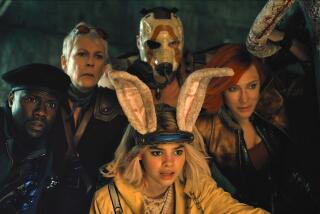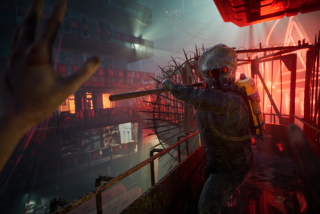The Player: ‘Late Shift’ is the first fully realized choose-your-own adventure movie. Or is it a game?
Early in the film “Late Shift,” Matt, a student on his way to a night job, faces an easily relatable dilemma: help a lost tourist with directions and risk being late to work or ignore the man and hop on a waiting subway train. Here is where you would expect director Tobias Weber to show the audience the outcome of Matt’s decision as the story unfolds.
Matt’s choice, however, is up to you, the viewer. In fact, you control every major plot turn in the film. “Late Shift,” created by CtrlMovie, a small studio in Switzerland, and written by Weber and Michael Robert Johnson, best known for Guy Ritchie’s “Sherlock Holmes,” may be the world’s first fully realized choose-your-own-adventure film.
Do you follow the orders of a car hijacker or a make a run for it? Do you trust the police or the whims of the woman offering you an opening to the underworld?
Each viewer — or player, depending on whether you define “Late Shift” as a movie or a game — must decide to act selfless or selfish, to fight or take flight. To become a hero or end up in a body bag.
Available now for Apple’s iOS devices, the $9.99 game-movie hybrid is a heist-thriller starring an ordinary man mixed up in nearly unbelievable circumstances. And because you control this man’s decisions, or at least the illusion of control, you are also the star.
Tap the screen on an iPhone, choose an option and and “Late Shift” seamlessly shifts direction. Two people can play the film and see two distinct plots play out, complete with differing locations. Each viewing runs between 70 minutes and 90 minutes, depending on the choices made, but all told, the “Late Shift” app contains about five hours of film.
Is this the future of moviemaking? Maybe.
Director Steven Soderbergh’s upcoming project “Mosaic,” largely shrouded in mystery, reportedly has some choose-your-own-adventure elements. And in late April, the multinational company Interlude revealed that it was working on an interactive reboot of “The Twilight Zone,” this after already unveiling that it was doing the same with “WarGames.”
Are these gimmicks? Or will the idea of a film as a passive experience soon start to change?
“That space between film and game is a very important space,” says “Late Shift” director Weber.
“Everyone is trying to go there, by one way or the other,” he adds. “A lot of games have become more and more cinematic. In terms of looks, they look better and better and more realistic. In terms of storytelling, games have also become more interesting. It’s not just shooting and puzzles. There are great stories being told. A lot of games are pushing in that direction. We wanted to achieve the same, but coming from the opposite direction, from the film side. We want to teach cinema a few new tricks.”
First, they need to conquer a few long-standing prejudices.
“When you say, ‘interactive move,’ people think, ‘I’ve seen that before and it doesn’t work. It’s boring,’” says producer Baptiste Planche, admitting that he and his partners at CtrlMovie encountered quite a bit of skepticism.
The choose-your-own-adventure film doesn’t have the most sterling of histories. Some may conjure images of the multiple endings of mid-’80s film “Clue,” or, worse, the scatological humor of the 1995 better-to-be-forgotten “Mr. Playback,” in which the pulse of the audience was taken via joysticks and tallied on the screen. The goal: Vote on which bodily fluids with which to pelt bad guys.
Briefly, in the 1990s, the full-motion video craze hit the gaming world. The arrival, in particular, of the Sega CD peripheral for the Genesis home console seemed to herald a future in which games would look more like films, only the quality was poor and the choices were limited.
Today, games are more cinematic than ever — see the branching, narrative-first works of Telltale Games or the teenage mysteries “Life Is Strange” or “Oxenfree” — but they’re animated.
There’s one recent — and important — exception: “Her Story.” The mobile game, created by Sam Barlow, asks players to piece together a mystery by watching jumbled police interrogation videos. The player is part detective, part librarian, as different search terms lead to different live action clips.
Barlow, today the creative director at Interlude and the man overseeing “WarGames,” compares interactive film to live theater — or stand-up comedy.
“It goes back to the idea of a campfire storyteller or the way a play before a live audience is different to a play to an empty house. The storyteller is in control, but the audience is providing feedback, it’s a dialogue. The audience is complicit, and the audience knows someone is paying attention to them. That’s important.”
When Weber first mentioned “Late Shift” to screenwriter Johnson, his mind bypassed any previous film experiments and instead flashed straight to ‘80s fantasy books from Dungeons & Dragons creator TSR or Steve Jackson Games. You may remember those from your own childhood. Chapters would end with a choice — say, fight the gnome or run to safety and then offer the reader two page numbers to pick from.
Thus, Johnson’s first fear: “You did not want the cinematic version of turning the page. You didn’t want to pause.
“I play a lot of games, so the idea of something that was half game and half film was very attractive,” he adds. “Then there was the question of whether it could be done.”
The team at CtrlMovie knew there could be no freeze in the action. “As soon as it breaks, it’s something you don’t like. It’s something you don’t want to do,” says Planche.
In “Late Shift,” players will direct lead character Matt, as portrayed by actor Joe Sowerbutts, through the plot. Matt, a mathematics student, works in a car park. An attempt to steal a vehicle leads to a heist, which in turn sets off a series of events in which the player will try to prove Matt’s innocence, perhaps with or without the help of criminal-turned-friend May-Ling (Haruka Abe).
Players will have only a few seconds to decide. Some will subtly shift the dialogue. Others are more dramatic. Do you pull the trigger of a gun, for instance? But at no point during the decision-making process does the film stop. Characters keep talking, the action keeps unfolding and once the choice is made there’s rarely a discernible cut.
“Late Shift” has seven conclusions, only one of them fitting into the standard Hollywood mold of a happy ending. In two play-throughs, I haven’t found it, as the logical approach of Matt clashes with the go-with-her-instincts nature of May-Ling, and I keep reaching conclusions with the latter dead.
Maybe my inability to reach the so-called good ending means I don’t know genre conventions as well as I thought. Or perhaps I think the strings I’m pulling will simply lead to better theater.
“This isn’t about you, the audience, being dropped into a story,” says Barlow of the format. “We want to tell stories about strong characters, and we get that sometimes the audience wants to see bad things happen the characters, they want what’s best for the drama. It’s a complex, layered relationship that the audience has with the story — and that’s great news for those of us who want to play and interact with that.”
So maybe I’m purposefully avoiding genre tropes.
“In the linear, Hollywood movie, Matt would learn from May-Ling and there would be a conventional happy ending,” says Johnson. “That’s one of the possible endings. But other endings are where he doesn’t learn, or he only learns half. It is quite difficult to lead him to the good ending.
“How strange it is to watch a film where you get at the end, and for no other reason than the audience made the wrong decisions, the girl is dead, you have no money and you’re taken off by armed police. Bam. Credits. It’s such an odd experience because you’re trained to expect the happy ending, come what may.”
“Late Shift” had a shooting budget of $1.5 million, a number that was initially higher but had to be scaled back when the CtrlMovie team went looking for investors. More than once they heard a familiar answer: No.
“We have a lot of public funding in Switzerland,” Planche says. “Several of them didn’t fund us because they said it would not work. They said people don’t want this in the cinema. They said theater people want to lean back.”
Perhaps that’s why Johnson thinks it works best on an iPad or an iPhone rather than in the majority-votes arena of the cinema. CtrlMovie will be at Marche du Film, the Cannes Film Festival marketplace, showing the work. The company hopes to license the technology to others. “Late Shift,” then, was something of a test — a proof of concept.
The stakes felt higher in “Late Shift” than they do in most games, where the action is often over-the-top and the bullets are in endless supply. There is, for instance, no extra-life in “Late Shift.”
“The format is about decisions and consequences, so we wanted to show that in real life, you cannot shoot people,” Weber says. “And if you do shoot people, you will have consequences. In games, you shoot pixels and there often aren’t any consequences. You can still win at the end. We wanted this story to be more like, ‘You cannot shoot pixels. You are shooting characters in a film.’ That relates to you more on a human level. They’re human beings.”
More to Read
The biggest entertainment stories
Get our big stories about Hollywood, film, television, music, arts, culture and more right in your inbox as soon as they publish.
You may occasionally receive promotional content from the Los Angeles Times.











